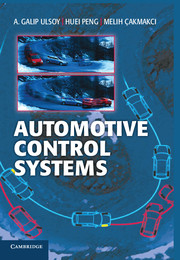Book contents
- Frontmatter
- Contents
- Preface
- Part I Introduction and Background
- Part II Powertrain Control Systems
- 6 Air–Fuel Ratio Control
- 7 Control of Spark Timing
- 8 Idle-Speed Control
- 9 Transmission Control
- 10 Control of Hybrid Vehicles
- 11 Modeling and Control of Fuel Cells for Vehicles
- Part III Vehicle Control Systems
- Part IV Intelligent Transportation Systems
- Appendices
- Index
- References
8 - Idle-Speed Control
Published online by Cambridge University Press: 05 June 2012
- Frontmatter
- Contents
- Preface
- Part I Introduction and Background
- Part II Powertrain Control Systems
- 6 Air–Fuel Ratio Control
- 7 Control of Spark Timing
- 8 Idle-Speed Control
- 9 Transmission Control
- 10 Control of Hybrid Vehicles
- 11 Modeling and Control of Fuel Cells for Vehicles
- Part III Vehicle Control Systems
- Part IV Intelligent Transportation Systems
- Appendices
- Index
- References
Summary
One of the most important and basic engine-control functions is idle-speed control. It requires consideration of the complete engine dynamics (as described in Chapter 3 about engine modeling) and has been a focus of various researchers to improve the performance of current and future engine designs (Grizzle et al. 2001; Wang et al. 2001). This chapter discusses engine idle-speed control.
The engine speed at idle is maintained at a desired value despite changes in engine loads (e.g., due to accessories such as an air-conditioning compressor). The controlled variable is engine idle speed and it is measured as discussed previously. The variables manipulated by the controller include the throttle angle and the spark advance. An optimal control approach provides an effective framework for the study of engine idle-speed control (Hrovat and Powers 1988). In this approach, we consider a vector, x, of state variables and a vector, u, of control variables. The problem then becomes finding the optimal controls, u*(t), which minimize an objective function J(x, u) subject to constraint equations g(x, u) = 0. In general, this is a complex problem because J and g are difficult to determine and the problem, once formulated, is difficult to solve.
- Type
- Chapter
- Information
- Automotive Control Systems , pp. 126 - 130Publisher: Cambridge University PressPrint publication year: 2012

